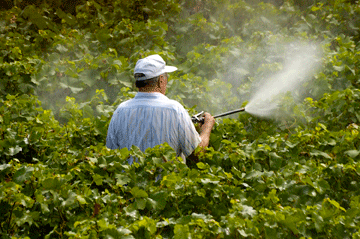Pesticide drift is an insidious threat to human health as well as to wildlife and ecosystems in and around agricultural and even residential areas where harsh chemicals are used to ward off pests. Children are especially vulnerable. Photo cred: iStock/Thinkstock
Dear EarthTalk: What is “pesticide drift” and should I be worried about it?
— Nicole Kehoe, Burlington, VT
If you live near a big farm or an otherwise frequently manicured landscape, “pesticide drift”—drifting spray and dust from pesticide applications—could be an issue for you and yours. Indeed, pesticide drift is an insidious threat to human health as well as to wildlife and ecosystems in and around agricultural and even residential areas where harsh chemicals are used to ward off pests. The biggest risk from pesticide drift is to those living, working, or attending school near larger farms which employ elevated spraying equipment or crop duster planes to apply chemicals to crops and fields. Children are especially vulnerable to these airborne pesticides, given that their young bodies are still growing and developing.
“When pesticides are sprayed they can drift and settle on playgrounds, porches, laundry, toys, pools, furniture and more,” reports the non-profit Pesticide Action Network (PAN). “Some of the most toxic pesticides in use in the U.S. today are also the most drift prone, and yet this common route of exposure remains largely invisible.”
“Even the most careful, responsible pesticide sprayer cannot control what happens to pesticide droplets once they are released from his plane or tractor,” the group adds. “And when conditions are right, these droplets can end up settling on someone’s yard, on another farmer’s crops, or on the skin of someone who happens to be at the wrong place at the wrong time.” PAN cites research showing that upwards of 95 percent of applied pesticides miss their target, reaching nearby people and wildlife, waterways, soil and air instead. Besides this “spray drift,” PAN also warns of so-called “volatilization drift”—whereby pesticides evaporate into the air from off of crops or out of the soil for up to several days following an application.
Thanks in large part to advocacy by PAN and other groups, the U.S. Environmental Protection Agency (EPA) has made strides in protecting more of us against pesticide drift. In late 2009 the agency rolled out new guidelines directing pesticide manufacturers to include labeling on their products indicating how to minimize off-target spray and dust drift. Any spray pesticides manufactured or labeled as of January 2012 and for sale in the U.S. must display the warning on its label: “Do not apply this product in a manner that results in spray (or dust) drift that harms people or any other non-target organisms or sites.”
The EPA is also conducting and monitoring new research on the science of pesticide drift to better understand how it works so regulations can be tailored to mitigate its impact. The agency’s Drift Reduction Technology Project is working with three leading universities to test a wide range of nozzles, hoods, shields and other aids to minimize drift during ground and aerial applications of pesticides.
Even though spray pesticides are now labeled and 28 states have drift spray regulations on their books, pesticide drift continues to be a problem wherever crops are grown. If pesticide drift is an issue where you live, work, study or play, contact PAN. The group can send out a “Drift Catcher”—a device that collects air samples which can then be analyzed for pesticides. “It enables farmworkers and community members to document and draw attention to otherwise invisible chemical exposures,” says PAN.
CONTACTS: PAN, www.panna.org; EPA, ww.epa.gov/pesticides/factsheets/spraydrift.htm.
EarthTalk® is written and edited by Roddy Scheer and Doug Moss and is a registered trademark of E – The Environmental Magazine ( www.emagazine.com). Send questions to: [email protected]. Subscribe: www.emagazine.com/subscribe. Free Trial Issue: www.emagazine.com/trial.








